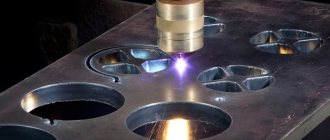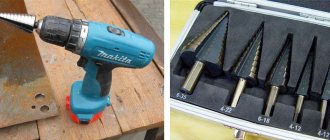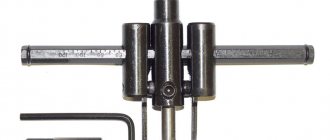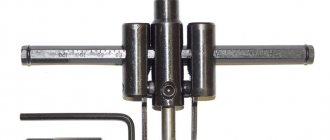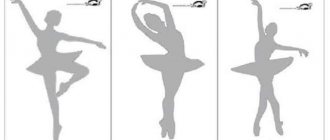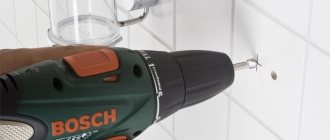Modern ceramic tiles are an excellent finishing material, actively used in construction and renovation.
Its excellent characteristics make it an almost irreplaceable material for finishing walls, floors and other surfaces.
It is beautiful, durable, waterproof, practical, hygienic, easy to care for, and has a fairly reasonable cost. If desired, anyone can learn, albeit not professionally, but to lay tiles carefully and efficiently.
[contents]
Is it possible to drill tiles with your own hands? After all, whatever one may say, holes will be needed sooner or later: for attaching shelves and various accessories, for hanging furniture, for carrying out various communications, for installing switches and sockets, and for other possible needs.
Device Features
The ballerina got its name due to its external similarity, because it consists of a central stabilizer and a drill that passes through the stabilizer on the side and exits through the other side. The device looks like a compass and actually works the same.
However, the ballerina alone will not be able to make the required hole of a certain diameter in the tile. To do this, you will need a regular drill and suitable tile drills.
How to drill ceramic tiles - select a tool and drill according to all the rules
When the walls in the bathroom and toilet shine with brand new tiles, it’s a pleasure to look at them. But the renovation is not finished yet - we need to hang the shelves and fix the mirror. But not everyone knows how to drill ceramic tiles correctly to prevent accidental chips. Alas, fragile ceramics are very easy to damage, and then a wonderful repair will go down the drain. In order not to rack your brains about where to get tiles to replace damaged ones, you need to know how to work with them. Read about it further.
How to use a ballerina correctly
First of all, it is worth noting that all work in this case is carried out exclusively on the front side of the facing material.
- First of all, you need to measure a point on the tile that will mark the middle of the required hole.
- Next, you need to use a drill with suitable drill bits, drill at the indicated point about 2/3 of the total thickness of the tile, at this stage you will need to remove the tile drill.
- Instead, a ballerina is installed, the central stabilizer of which is installed in a pre-drilled, blind recess in the tile.
Thus, using a drill, the ballerina is used as an attachment, with the help of which it is possible to carefully make a hole of the required diameter. All you need to do is put the stabilizer in the right place and start the device.
DIY making
When you don’t have a device at hand that can cut a circle from wood or other material, you can try to make it yourself. To do this, you will need a collet holder and a set of the required size of feather drills. A collet holder is a clamping mechanism that is used to clamp a rotating cutting tool. It can be made from a bolt, the diameter of which depends on the chuck of the rotator, machine tool or drill. The head of the bolt needs to be cut off and sawed crosswise along the thread side.
The center drill is sharpened into a cone, and the cutting drill into a wedge. In this case, the end of the center drill should be 3-5 mm longer.
The drill is held in place by two nuts: one is a clamping nut, the other is a guide. If holes with a constant radius are cut, then the drill can be welded to the holder.
What drills to use
The central stabilizer can be replaced, this is due to the different characteristics of the materials for which it can be used. It is worth noting that conical drills are not allowed for use on tiles.
This is due to the fact that, due to the peculiarities of their design, they can slide off the intended, pre-deepened point and scratch the front surface of the tile.
For this reason, it is recommended to use auger or type 1 drills for these purposes. They are ideal for these tasks. It is worth noting that it is not always necessary to drill with a ballerina until the inner circle is completely separated from the tile, thus forming a hole.
- Some tiles have an extra layer at the back that is not tile, a hard material designed to improve the tile's adhesion to the stucco wall surface.
- In such cases, it is enough to drill with a ballerina to a depth of no more than 2/3 of the total thickness. After this, you can carefully knock out the resulting circle. The disadvantage of this method is that on the reverse side, when knocking out, chips form on the material.
However, you shouldn’t worry about this, because the back side of the tile will be attached to the wall using a primer, so the chips will be hidden from view. In addition, they will not affect the quality of adhesion between the surface of the slab and the wall, because the vast majority of the area's materials remain intact.
How can you make a hole?
To make a hole in a tile use:
- Drill:
- Spear-shaped;
- Tubular;
- Spiral with pobeditovy cutter;
- Diamond-coated crowns;
- Ballerina;
- Cutting disc with grinder;
- Diamond-coated string;
Depending on the amount of work and the type of tile, one or another device is used. Among them there are universal and highly specialized.
- Drill.
Spear drills have 2 or 4 edges. The second option is less common. The edges are formed by soldering, which are made of pobedite alloy. Spear drills are intended only for drilling tiles. Some manufacturers produce models for porcelain stoneware, but practice has shown their poor functionality.
They go through tiles very easily. The cheapest models of a domestic brand cost 60-70 rubles. But you can only use them 5-7 times, then the tip flies off.
If you drill wet, you can double the life of cheap drills.
Expensive models from Bosch or KWB cost an order of magnitude more, 600-700 rubles. Of course, if handled carelessly, they can also break, but careful use is guaranteed to make more than one hundred holes.
Tubular drills represent a qualitatively different level of consumables. In appearance, it is a high-alloy steel tube with diamond coating on the working end. They are already able to cope with porcelain stoneware and Metlakh tiles. Almost always, the manufacturer recommends using them for wet drilling.
The cheapest models of the domestic brand “Praktika” cost 150-170 rubles. Expensive ones, from Bosch or MESSER, will cost 2.5-3 thousand. Moreover, in expensive models, the dry drilling function is implemented. This option is made possible thanks to vacuum deposition of abrasive material and the integration of a miniature coolant container.
Twist drills with a Pobedit cutter occupy a special position. They are rather an upgrade of conventional models, but their intended purpose is deep holes in durable material. This is confirmed by the spiral grooves, which remove dust very well when working with thick tiles.
The cutting edge can be positioned horizontally or at an angle. In the first case, there is a sharp protrusion in the middle for centering. Prices range from 120 rubles for cheap models, to 700 rubles for branded products.
- Diamond-coated crowns.
Structurally, they can be thought of as tubular drills of large diameter. But these are more complex devices. Depending on the diameter and model, they can have from 8 to 36 teeth, or without them. Some of them do not even have segmenting slots, that is, this is a real large-diameter tubular drill.
All models must have a centering drill in the center.
There is no clear division of them according to any characteristics into tubular drills and crowns. Some manufacturers produce drill bits without a shank with a diameter of 8 mm, while other companies offer tubular drills with a shank, ø20 mm.
But in any case, for large-diameter holes, diamond-coated crowns are used.
The cheapest models cost 180 rubles, the most expensive from RUBI, 11-12 thousand.
- Ballerina.
A convenient device in the form of an h-shaped compass, with the possibility of adjustment. The central leg is an analogue of a spear-shaped drill. A cutter, most often made of a tungsten carbide alloy.
Almost all of them can drill a hole from 20 to 90 mm. Some models are equipped with a protective screen. Price from 350 to 1000 rubles.
The ballerina is attracted by the possibility of adjustment, and an inexperienced buyer is attracted by this feature. But they are extremely inconvenient to use! The reason becomes clear if you imagine the ballerina not as a device for work, but as an eccentric. When drilling, even at low speeds, the vibration is so strong that it takes considerable effort to hold the drill in one position.
- Cutting disc with grinder.
This option can be considered indirect, because the holes are made not by drilling, but by sequentially cutting closely spaced slits. The method is labor-intensive, the edges are uneven. But it is possible to make a cutout in the form of any figure of the correct shape: a square or a triangle.
The disc is required to have a smooth edge and diamond coating.
It doesn’t make sense to buy it specifically, and more often this option is used if the work takes place in emergency mode.
- Diamond coated string.
This is an ideal device for cutting holes of any geometric shape, in all tiles without exception. It is a string with ears on which an abrasive coating is applied. The material can be different, from tool steel to tungsten. It cuts any tile like butter. The only negative is that mechanization is impossible; all work must be done manually.
Price from 200 to 600 rubles. If you don't break it on purpose, it will last for several years.
Adjusting the ballerina
Before you begin, you need to loosen the tightening screw on the central stabilizer of the device. This screw clamps the working drill, through which drilling occurs.
By loosening the working drill moves from the axis of the central stabilizer to the required distance, indicating the required circumference of the hole in the tile.
After the desired value has been set, the tightening screw must be tightened back, securely fixing the working drill in the central stabilizer. The design is very simple, which allows you to make a similar tool with your own hands.
- If you are using not a classic ballerina, but a two-incisor one, the adjustment process is slightly different.
- First of all, it is worth noting that the cutters will be located in a fixed bracket at the same distance from each other.
- It is necessary to adjust each cutter separately, while maintaining the same distance from the central stabilizer in the bracket.
- Clamping screws are also used as a fastener; this design is very similar to the classic one.
A design with two or more cutters is more convenient to use, because drilling occurs several times faster than when using the classic model. However, adjusting the cutters is much more difficult; if the distance of the cutters from the axis is different, it will not be possible to create an even circle, as a result the tile will be damaged.
Advantages and disadvantages
The advantages include:
- possibility of changing the centering element;
- equipped with two types of centering elements;
- cutters can be sharpened;
- no additional processing required;
- reliable design;
- the locking screws are fixed by a cone;
- The screws are tightened using a hexagonal socket wrench.
Among the disadvantages it is worth noting:
- poor sharpening of cutters;
- on inexpensive models, when processing large diameters, breakage is possible;
- A high power drill is required.
Recommendations for using a ballerina
Before using this tool, please read the instructions and operating instructions carefully.
- Particular attention must be paid to the selection of drills to create a recess at the central point.
- If the shape and type of drill are unsuitable, the tile will simply crack, making it completely unsuitable for further use.
- The drill should be of small diameter to avoid cracking the material during drilling.
You also need to pay special attention to the fastening of the cutters in the ballerina; if the working surfaces are not securely fastened, they may fly off during work, which will lead to damage to the material.
In addition, there is a danger of injury to the master’s hands. Therefore, it is necessary to comply with all safety requirements, wear a protective mask and gloves, and respiratory protection to avoid injury.
Types of instruments
In addition to the classic two-cutting version of a circular drill, there are one- and three-cutting models. In the design of a single-cut drill, the cutting part is directly fixed to the rod. The cutter and centering lance are equipped with carbide plates. They make it easier for a ballerina to work on tiles.
In three-incisor models, the incisors are mounted on a round platform on which there are grooves. The cutters move along these grooves. They have a scale. Correctly set size allows you to cut more accurately and quickly.
Currently, some models are equipped with a protective grille made of plastic. It improves work efficiency and convenience.
The ballerina for metal is equipped with plates made of hard alloy with sharpening of a cutting turning tool. High cutting force dictates the use of stationary or portable radial drilling machines. Basically, holes are cut in galvanized sheets, the thickness of which does not exceed one millimeter.
Photo of a ballerina on tiles
Criterias of choice
Before choosing a “ballerina”, you need to know its main advantages over other devices for cutting large holes, be it crowns, jigsaws, etc.
Advantages of adjustable circular devices:
- the ability to replace the central drill or lateral incisors at any time;
- reliability of design;
- if necessary, cutting elements can be sharpened;
- adjustable hole width.
Now let's look at the parameters you need to pay attention to when purchasing
- Reliability. It is unlikely that you will be able to determine this criterion visually, so it would be better to check the quality certificates for the products from the seller. For low-quality goods, they most likely will not be available.
- Workmanship. Before purchasing, you need to carefully inspect the device for shells, chips and other flaws. The cutters must be well and accurately sharpened. If the drill is very long, then you need to check whether it is even. Usually these defects are visible immediately and by eye.
- Package. Quality products from well-known manufacturers usually come with bright and good packaging. There will be no grammatical errors in the text accompaniment. None of the well-known brands can afford to package their products poorly.
- Price. Cost can also be considered an indicator of quality. Inexpensive models last a very short time.
Famous brands care about their reputation, and their products will meet all quality criteria. Therefore, it is better to contact official dealers so that the money is not wasted.
The following video talks about the ballerina drill.




